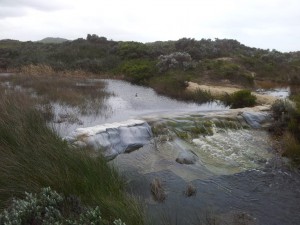Long Swamp Restoration Trial Update – June 2014
The rains of the last week or two have certainly started to make a difference to wetlands along our coast, with levels in Long Swamp and at the Nobles Rocks outlet being nudged back up again over recent days.
Since the last update, Lachlan and I have managed to head back down to Nobles Rocks to take some laser levels to measure the current impact of the trial structure, by precisely measuring the extent of the weir pool it has created.
It turns out that although the trial structure looks impressive, is working well and has reduced outflow efficiency (see photo below), it isn’t yet having a direct effect on setting levels in the swamp itself (although some smaller peripheral areas adjacent to the channelised stretch have been inundated) and we can’t raise the level of the existing structure any higher due to the adjacent bank height.
We were limited (for practical reasons such as access, channel depth and width) to initially working at the current location back in early May, because of the April breaking rains and significant flow we had to contend with in the channel. However, given our early observations, we are hoping to set up a much smaller, low-level sandbag weir very soon – right at the point where flows exit the swamp proper (about 150-200 m upstream of the present trial location). This interim step will:
- allow us to have an additional (albeit minor) influence on swamp levels this season; and,
- take some pressure (under higher flow conditions in winter) off the main trial structure.
Then next summer, when the site is dry, we’ll look to lift, shift and properly bed-in the main restoration trial structure – by preparing a properly levelled earthen base and moving the temporary structure upstream about 15-20 m. Although the channel is wider and deeper at this point (the reason we couldn’t work there this year in the wet), the high dunes either side will give us a much more stable (and height flexible) anchor point to work with.
We’ll continue to use our observations from the restoration trial, under its current configuration, to help refine and improve our plans as the trial progresses over the next 18 months, and – as always – we’ll continue to keep you up to date as that process unfolds.


